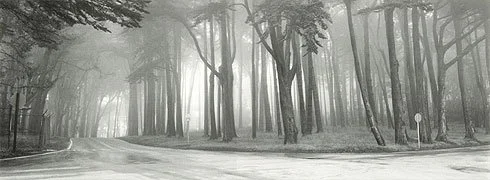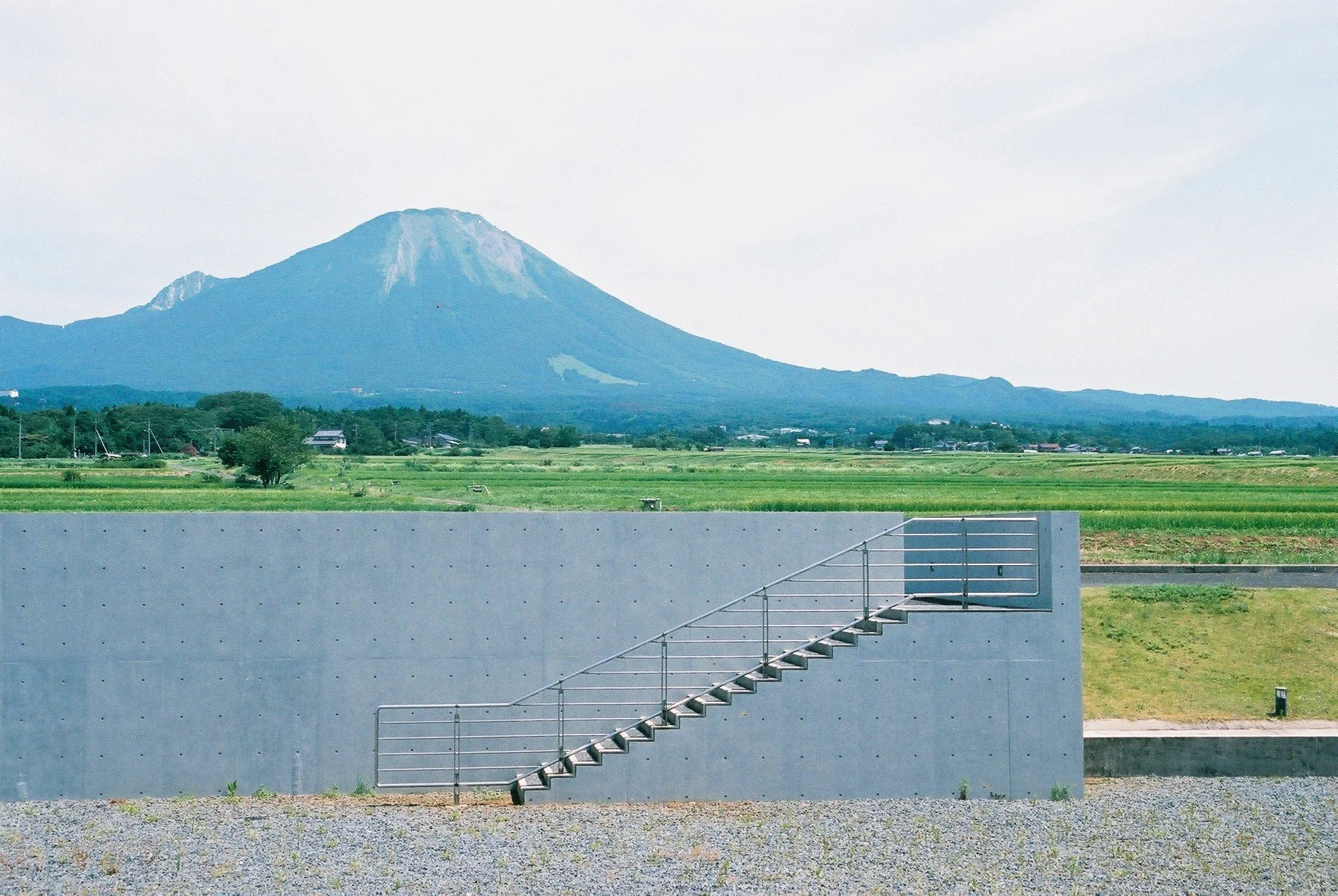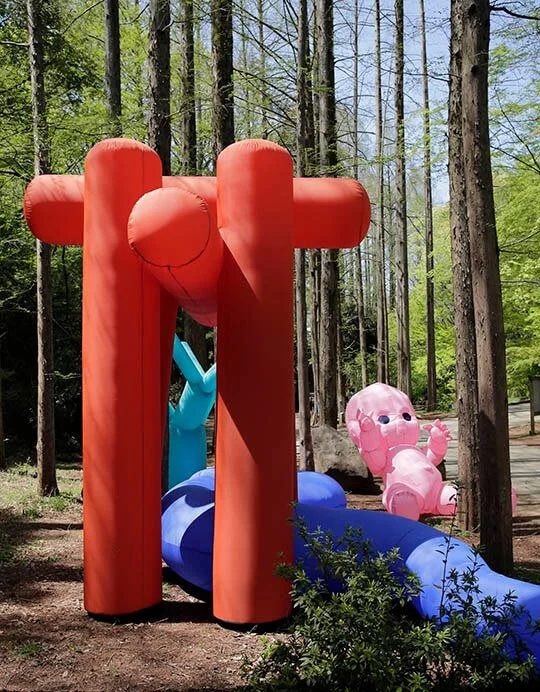I created a "New Arabesque" print installation and presented "New Arabesque II" at the MA Fine Art Show 2023 in July. Through the theme of landscape, New Arabesque examines the story behind the land from a narrative perspective. Comprised of layers of photographs and prints, this series explores the folklore of a specific location and draws inspiration from the land itself. These two mediums, photography, and illustration, offer different perspectives on the same landscape. I use symbolic landscape photographs that reflect human consciousness as symbols that represent the history of human faith and migration.
New Arabesque Ⅱ, projection on inkjet print on Shoji paper, looped, 2 screens, 100 × 200cm
In parallel with the projection, I also worked on etching prints using the digital print chine colle. I am interested in how these processes become a single image. I found it interesting that the process of printing with a press was like compressing two images, giving the impression that two different languages were fixed together. The use of Japanese paper in chine colle's digital prints creates a combination of traditional and mechanical textures. The line drawings in my work maintain a unique hand-drawn texture. This plays a vital role in expressing unique contrasts, so exploring it has become a theme for me. Seeing digital prints and prints as a unified entity is, for me, an important approach to telling conceptual stories centred around the past and present, and exploring this interplay more deeply.
The Land of Kuzuryu, etching with Chine colle, 98 × 68cm
“Field of Sight”, a photo painting series born from a collaboration between Gauri Gill and Rajesh Vanguard, has some overlap in theme and process with my own work. This project centres on stories rooted in the divinity of the earth, nature, animals, hills, trees, houses, and villages, but it also expresses the modern world, and the stories inherent in daily life. I'm trying to uncover the truth behind it.
Gauri Gill uses photography to tell visual stories that emphasize contemporary relevance. Using photography, Gauri aims to assert the presence of the present rather than the past. I think it's a clear line between painting and photography, as he clearly states that the photographic process is not done to evoke a traditional tribal past. This is also emphasized through words that utilize modern media and technology, such as photography and motorcycles. Meanwhile, Rajesh Vanguard's geometric drawings are inspired by traditional Warli paintings. He uses geometric elements such as circles and triangles to represent the sun and moon, mountains and trees, sacred enclosures, and parcels of land. Their work reimagines pictorial photography through a modern lens. Warli's fusion of historical and generational painting traditions with the language of photography creates a continuous narrative from past to present. Furthermore, they suggest that two distinct representational layers facilitate the continuous evolution of cognition and new ways of seeing.
Gauri Gill and Rajesh Vangad, Mountains and Trees, from “Fields of Sight”, 2014, ink on archival pigment print
When I think about it in terms of my work, I construct the medium of photography as a series of expressions of the "now." And the illustrations (prints) overlap there as a story of the past (or what might have been). The medium of photography is sometimes said to be a depiction of light, but I believe that all the information about the light now the photo was taken is gathered into a single image through the camera. I use a film camera because, due to the limitations of film, it cannot take continuous photos like a digital camera. By concentrating on a single screen when taking landscape photos, I am encouraging the act of capturing that moment as a picture. Therefore, the process of photography has become a very important process for me to recognize the relationship between myself and the landscape. On the other hand, layering illustrations are just secondary information from outside for me. However, it also connects oneself and the present to third parties and the history (past) of the place.
My primary research was an interview with Victoria Ahrens. The theme was our relationship with the landscape. I also asked her about the history behind certain places and the important messages behind her work. Through this interview, her personal experience revealed a kind of micro perspective within a larger landscape. It is sometimes her and her family's own story, but the story also reminds us of an unforgettable fact in history. She also said she used landscape photography as a metaphor. A single cropped image of her (sometimes manipulated by the artist) represents our ideal of natural beauty. However, by layering colours and images, the truth behind the beauty, which may not be beautiful, appears. I think this also applies to the relationship between illustration and photography in my work. Create a collision of materials and textures to see the message that emerges between natural landscapes and artificially created images.
Photography is the basic process of my work. Because it is the starting point for responding to a place. Photography and related experiences and information are in demand. My photography is not about visible images, but about capturing invisible atmospheres and more personal emotions. Therefore, avoid focusing on a single object. For example, photographer Lyle Gomez captures haunting beauty in his photo series. He says his own photography process is a solitary experience. I think that's what gives his photographs a quiet, intimate, and timeless feel. This shows that experience also influences images.
Lyle Gomes, San Francisco Presidio #1, 1989, from Imagining Eden: Connecting Landscapes
The landscape on the left below was taken on January 8, 2023, in Hakone, Japan. During my visit, I heard many stories about the Hakone area from a local. I became more interested in this place and started researching its history myself. The proximity of Mt. Fuji and Hakone Volcano makes this region of great geological interest. Lake Ashi, shown in the image, used to be a river, but a volcanic eruption dammed most of it and turned it into a pond. I imagine that the events caused by nature shocked people, and eventually developed into the folk tale of the Kuzuryu (nine-headed dragon) enshrined at Lake Ashi. In this way, we learned that Japan's various folktales have been created by natural disasters and the imaginations of the people affected by them.
Lake Ashi, Hakone Kanagawa, Japan, Photograph by Aya Kikkawa
Daisen, Tottori, Japan, Photograph by Aya Kikkawa
The photograph on the right is the scenery from my home town, Tottori. Mt. Daisen has been considered one of ’Japan's seven sacred mountains’ and has been the object of mountain worship. But at the same time, for us locals, it is a familiar place that provides fresh milk, meat, water etc. In Japan's Yaoyorozu no Kami (eight hundred gods) faith, mountains are considered sacred. I believe that the stories surrounding this must contain messages from our ancestors who have lived surrounded by mountains since time immemorial. My works are based on stories of coexistence with nature, and I try to focus on the stream-of-consciousness connection between mountains, land, and sea. While mountains provide people with many natural blessings, they can also bring many disasters. Living surrounded by mountains and the ocean means living under the influence of great forces that you cannot control. I thought about how to express the mountains, the wind that surrounds them, and the atmosphere that cannot be captured with a camera, and how to make them stand out while using two-dimensional works in the exhibition space. The two landscape photographs have different topographical backgrounds, but their sense of distance attempts to evoke an invisible space.
I found a familiar concept for me in Christian Boltanski's work Animitas (Spanish for 'little soul'). Christian Boltanski made ghostly and atmospheric installations. The work is an installation in a remote open area in different countries as a tribute to small roadside altars dedicated to the dead. There, the space and experience of the viewer were felt to be an integral part of the work. I thought it was emphasised that the artwork was only a contribution to the place. When Christian Boltanski talked about an exhibition he had done in a church in the past, he said: “Ideally, the people who came would not realise that there was a contemporary artwork there”. This is evident in his other work, where he builds his pieces around the memory and spirituality of the place itself. In particular, the slightest sound when someone passes by a wind chime or when the wind blows establishes a momentary relationship between nature and the artwork. These installations invite a kind of invisible connection between the countries, different locations and even the white cube as well.
URL: SkulpturenPark Hellbrunn Christian Boltanski Klanginstallation „Animitas“ 15.7.2019-31.3.2021, SkulpturenPark Hellbrunn Christian Boltanski Klanginstallation „Animitas“ 15.7.2019-31.3.2021, SkulpturenPark Hellbrunn Christian Boltanski Klanginstallation „Animitas“ 15.7.2019-31.3.2021
New Arabesque Ⅱ featured such a space relation between mountains. Because one of the major characteristics of Japan's land is that most of it is covered in mountains. The topography of the Japanese archipelago is rugged, with approximately 75% of the country's land covered by mountains such as volcanoes and hills. The mountains form small valleys, the slopes are generally steep, and the area is mostly forested. Mountainous borders are visible from almost every corner of our region, except for the metropolitan landscape. This reflects our consciousness and I believe that it makes the form of our landscape.
Japanese religion is a mixture of nature worship and Buddhism, but the most important concept in Shinto is the "meaning of place." This core principle derives from the close relationship between Shinto beliefs and Japan's unique climate and environment. Throughout its history, Japan has coexisted with many natural disasters, such as earthquakes, typhoons, and volcanic eruptions. This reality, combined with the awe-inspiring and uncontrollable forces of nature, deeply influences Japanese thinking. From "Memories of Sacred Places: The Japanese Body'' Toji Kamata delves into the rich tapestry of folklore and legends associated with these regions and draws out their connections to Shintoism. Although these stories are often considered urban legends, in the spiritual realm they metaphorically appear to convey profound truths. In modern Japanese anime and manga culture, anthropomorphism is very prevalent, and it is interesting to consider that this is combined with legends, which may be urban legends formed by the local climate. Therefore, when we explore the history of Japanese storytelling, it becomes clear that the Shinto reverence for nature as a living organism is deeply and unbrokenly ingrained in the culture.
Also, in terms of Japanese thinking about nature, I am inspired by Shiro Takahashi's "Pneumatic Sculpture Series", which examines Japanese mythology with Aminism. He drew himself inspiration from the Japanese Kojiki, a series of ancient stories and myths called the "Ancient Records." He researched the culture and history of the use of “Ki”, which refers to the human spirit, heart, and energy, from ancient times to the present day. As a result, he used “pneumatic technology” to capture the “Kiusodai” (a concept that means that the way of thinking and way of thinking is large and grand) of the gods that appear in the stories and myths of the Kojiki. Although this work is based on the Kojiki, which is the source of faith, it has a fun and approachable feel to it, and I think this sense of distance clearly expresses the religious beliefs of people living in Japan.
Shiro Takahashi, “Omoya no Kami”, 2019, nylon, blower & "Daiji no Kami", 2006, nylon, blower, motor
I feel that the layered illustrations in my work are closer to symbols and information obtained from the outside, unlike photographs that allow one's inner self to bloom. I researched line drawings and patterns as cultural meanings. Behind the scenes, exchanges with other countries can also be seen. In particular, arabesque patterns are widely used around the world, incorporating each country's unique characteristics in their own way. Arabesque patterns, popularly known as Karakusa patterns in Japan, are spiral patterns woven with spiritual animals and natural elements. Since it spread around the world along with religion, it has been used for religious decoration in many countries. On the other hand, arabesque patterns have been used in Europe since the Arts and Crafts movement in England. In an attempt to encourage a return to nature in British art, the arabesque pattern can be said to symbolize nature in the mental image that is born in dialogue, going beyond nature itself.
The repetition of spiral patterns may encourage humans to feel calm and be curious about beauty. It is also thought that the reason it came to Japan along with religion was to encourage meditation on that kind of spirit. The story of the migration and evolution of arabesque patterns reflects the psyche of people not only in Japan but around the world, and also provides a glimpse into the history of people's migration.
The decorative style of the 19th-century Art Nouveau movement was deeply connected to French clinical psychology, which understood the internal organization of the human body as a mechanism of sensory nerves. The organic curves of Art Nouveau were thought to be associated with undulating movements of the nerves, hypnotic suggestion, and dream induction. It is interesting to note that Jean-Martin Charcot, a professor of pathological anatomy, decorated his family's apartment on Boulevard Saint-Germain in Paris with leaf arabesques and ironwork, experimenting with ways to “transport dreams outside''. Moreover, certain patterns and close relationships with humans can also be seen in Hilma af Klint's works. Her works look like abstract paintings that have a psychological effect on the human brain, but their inspiration, which imitates natural landscapes and plant forms, is reminiscent of people's exploration of arabesque patterns.
What exactly is the boundary between the image in a person's mind and the landscape that appears in reality? I wanted to tackle this question by taking a different material approach. While exploring various combinations of artistic media, a concept emerged. Laser-cutting the woodblock reveals a striking contrast between the organic texture of the wood and the precision of the printed lines. When I looked at the surface of the print, I realized that both the woodblock and mechanical processes were present at the same time. Woodblock prints encouraged a deep relationship with the material of wood. The suppleness and texture of wood made me realize that it is a primitive substance from nature, and making woodblock prints became a process of confronting this.
Laser-cut woodblock print on Kozuke paper, 20 × 42cm
Laser-cut woodblock print on Kozuke paper, 20 × 42cm
My project also considers the sense of time. As a part of my practice, I went to Regents Park and took a video of the scenery in the park from a fixed point to think of what makes sense of time in view. In this research, I investigated the relationship between static and kinetic things in the natural world and realized that the movement of objects creates a sense of slow time. Kinetic humans or living things tend to be excluded in landscape photography. However, in this video, the movements of living things function as part of nature. It also makes us realize that all nature and living things have their own speed.
Video practice in Regents Park, London, Duration: 9min 23sec
For New Arabesque, I worked to add movement to still images. By creating subtle movements in nature, I intended to convey that there is will even within nature. Crispin Sartwell’s “Six Names of Beauty” offers various aesthetics from six different countries. In it, the Japanese aesthetic sense of wabi-sabi is also described. In contrast to the Western sense of elegance and flamboyance as beautiful, wabi-sabi sees simplicity and modesty as beautiful. It also encourages the enjoyment of ephemeral and temporary beauty and ‘beauty of the moment’, influenced by the changing of the seasons, and the beauty of the moment is considered an important part of life. Here, the Japanese view of nature and landscape is also reflected in wabi-sabi, which is a latent sense of beauty that is reflected in the ephemeral nature of time, which is not eternal and is constantly changing and changing, as it coexists with nature.
Projected image for New Arabesque Ⅱ
Over the past year, I have been creating works that straddle multiple media and processes. When looking at the finished work, the contrast between woodblock printing and etching printing, and the alternation of handwork and machine processes, becomes apparent. For me, I think that friction between materials should continue to receive more attention and research. For the upcoming research festival, I am planning to produce a zine with the theme of dialogue between us and the land. Regarding the theme of "dialogue," I hope to also create a mutual relationship between artists by juxtaposing Victoria Ahren's interview with answers to my own questions.
Gomes, L. (2005) Imagining Eden: Connecting landscapes. Charlottesville: University of Virginia Press.
Grewal, I. (2015) Gauri Gill and Rajesh Vangad: ‘Fields of sight’, Trans Asia Photography. Available at: https://read.dukeupress.edu/trans-asia-photography/article/doi/10.1215/215820251_5-2-205/312772/Gauri-Gill-and-Rajesh-Vangad-Fields-of-Sight (Accessed: 31 October 2023).
Pastore, J. (2019) Inflated with the Spirit: Shiro Takahashi and the Kojiki, Artscape Japan. Available at: https://artscape.jp/artscape/eng/focus/2009_02.html (Accessed: 31 October 2023).
Klint, H. af et al. (2023) Hilma af Klint & Piet Mondrian: Forms of life. London: Tate Publishing.
Minato, C. and Nagahara, Y. (2008) Sozosei no Uchu = universe of interaction: Soseiki Kara Joho kukan e. Tokyo: Kosakusha.
Ito, T. (2022) Karakusasho: Soshoku Monyo Seimeishi. Tokyo: Ushiwakamaru.
Tanaka, J. (2005) Ornament as Mass: Geneology of Neuronal Urban Studies, 10 + 1 Database. Available at: https://db.10plus1.jp/backnumber/article/articleid/622/ (Accessed: 31 October 2023).
Kamata, T. (1996) 聖なる場所の記憶: 日本という身体. Bunkyo, Tokyo: Kobunsya.
Sartwell, C. (2004) Six names of beauty. London: Routledge.











